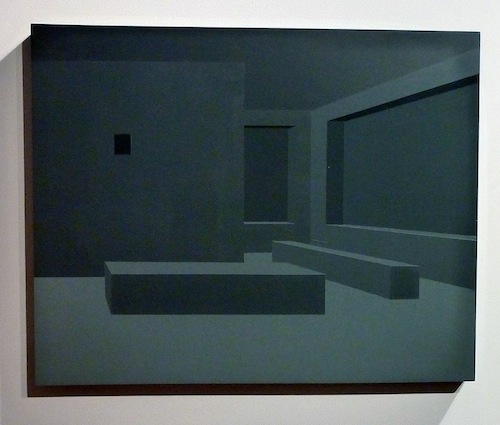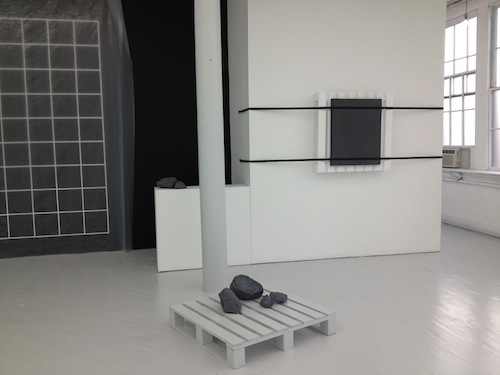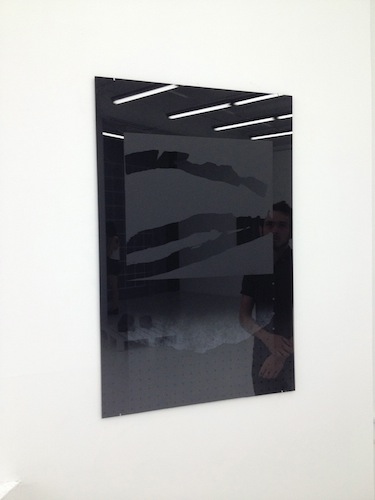This summer James Bouché’s work has been all over town and I will admit I have not been the biggest fan. First, there was a group show at Guest Spot, then an Artscape Show at Gallery Four, and most recently the Print/Collect project curated by Jen Coster at Current. Maybe this is a personality flaw, but I find an excess of straight lines in visual art to be boringly, predictably male. And two-point perspective reminds me of seventh grade art class.
No big surprise, then, that minimalism leaves me cold. I don’t even like architecture that’s too straight or slick – I prefer buildings with unexpected softness, curves or wonky angles, trappings of age. After mostly growing up in the plastic 1980’s, I’m predisposed to distrust anything that looks new or fabricated, and, conversely, nothing signifies authenticity like a crooked, hand-wrought mark. In spite of my knee-jerk reaction to Bouché’s work, or possibly because of it, I decided to visit his solo exhibition at Springsteen Gallery, titled Not Yet In Ruin. We all know there is no substitute for experiencing artwork in person, especially when installed under ideal conditions. In three dimensions, James Bouché’s work was not what I expected.
Before visiting, I read Marcus Civin’s essay on Bouché in the Print/Collect catalog, where he describes the work as “loaded mechanics” that are “highly suggestive” in their multiplying and oozing, and I was even more set in my dislike. For those who don’t know, Bouché depicts empty, geometric structures and single, cracked book-shapes on glass and metal in a sober palette of gray, black, and white. Where is the ooze? Reproduced on paper, these works are cerebral and austere, at best. However, in person they are sensual, even sexy, in the most unexpected ways.
Take ‘Slab and Pallet Strapped to Wall,’ the first piece you encounter when you enter the space via a narrow white hallway. All you can see is the edge of two black restraining straps, which could be holding anything hostage around the corner. Momentum builds as you walk ten steps to see the cords serve as a framing device for a gray textured rectangle, placed atop a wooden shipping palette painted matte white. Despite the simple, symmetrical composition of ordinary elements, there’s something obscene about this piece, and the straps, ready-made from a shipping warehouse, transform these objects in the same way that Victorian piano leg covers made piano legs indecent. In short, it’s hot. It shouldn’t be, but it is.
Scanning the rest of the gallery, a modest sized room with stark white walls, wood floors painted light gray, and frosted glass windows, Bouché’s other works are strangely animated in this artificially sterile environment. This wouldn’t be obvious at a crowded opening, but alone in the gallery, you are able to physically enter one of the barren, arcane spaces from a Bouché painting. The gallery becomes a minimalist temple, full of opaque monuments and riddles to solve. You are possibly in the future or another plane of existence and the transformation is immediate and rather thrilling. This energy imbues all the works in the show with a dramatic, emphatic presence.
‘Structure No. 4’ hums slightly from across the room, where a black silhouette of a placard sign floats in the middle of a giant white canvas. The painting becomes thing-like and sculptural, propped up on a rough pedestal of cement blocks instead of hanging on the wall. Out in front, a diagonal row of fluorescent lights throws a wan pinkish glow onto the lower portion of the painting. Like an altar to an absurd god or a monument to an emblematic event, this piece has a powerful, even menacing, presence. There are no logical reasons for these disparate items to cohere, but they do.
Two smaller glass panels, ‘Leaning Laws’ and ‘Broken Rock at 2 am,’ combine techniques and materials appropriate for expensive kitchen cabinets, like etched glass, steel shelving, and black pegboard. The slick surfaces of both pieces reflect, so a viewer must concentrate to see the imagery within. ‘Leaning Laws’ depicts a cracked stone tablet in white on a clear pane of glass, a reference to an ancient religious text that floats and almost disappears on the surface. In contrast, ‘Broken Rock’ is glowing metallic black, reminiscent of hematite. It is dense from black materials layered under and black paint on both sides of the glass. This piece also floats a central rectangular shape, but it is matte and sits on top of the surface, where the artist has razored off some of the paint off to reveal a contrasting depth. Both works require that you peer into and through them like a window, rather than at them like a picture.
Consistent with the other works in the show, the panel pieces are simultaneously simple and vague, while possessing a physical depth that provokes a visceral, emotional reaction in person. This must be the ooze Civin was talking about. It’s not in the work itself, but in the reaction to it.
James Bouché: Not Yet In Ruin is up at Springsteen Gallery through September 6, 2013. Do yourself a favor and visit in person. Gallery hours are Saturdays, 12-4.










